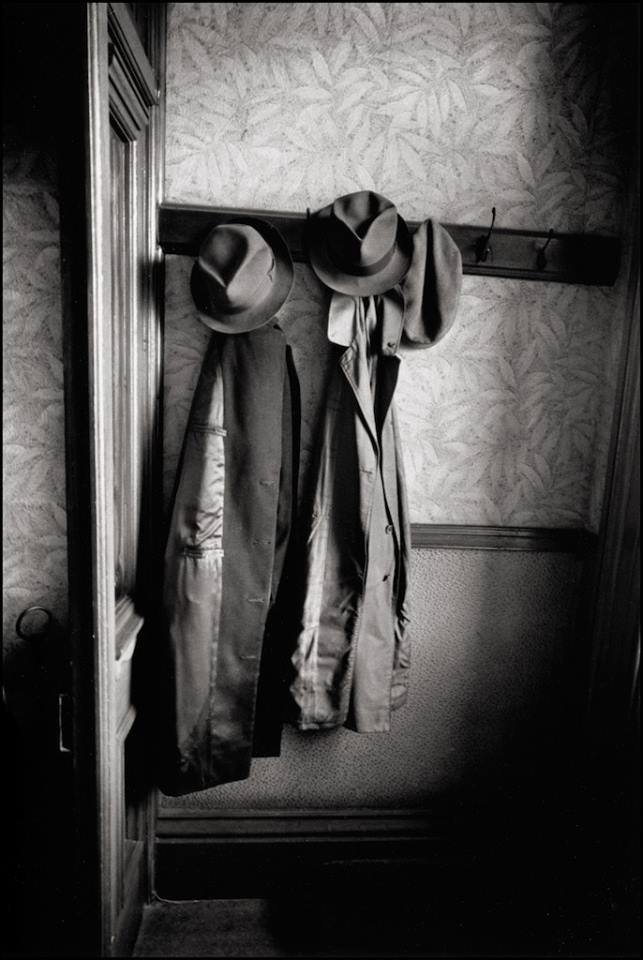In the fourth instalment of Painting the North, Ant Cosgrove, the man behind The Northern Art Page on Facebook, shares striking works of art, sketches and drawings from around The North of England. As the weeks progress, Ant will bring you his image of the week from the popular social media page. This week, we’ve got something a little bit different as he shares the story of photographer, Denis Thorpe, who managed to capture scenes from L.S Lowry’s home before it was emptied of its belongings.
Ant says: Laurence Stephen Lowry died aged 88 on February 23, 1976 at Woods Hospital in Glossop. The following morning, under instruction of the executors of the will, two removal vans arrived at his home, The Elms, in Mottram in Longdendale, Tameside. Overnight there had been a police presence at the property and, by morning, word had spread and local people were in the street gossiping and taking photos.
Lowry was a famous artist, and known for living alone. The contents of the house would be worth a vast amount of money. Indeed, the dealer Andras Kalman said there could anything up to £500,000 worth of paintings scattered inside. There would be no time to waste in making sure these items were removed for safety, then stored in a branch of the National Westminster Bank. A bank official who helped to supervise the operation said that they had to work fast and had called in a firm of valuers to record everything. At that point, the items were just being listed and no attempt was being made to value them specifically.
“Our main concern is to get them out of the house before it is burgled,” he said. “It is a gold mine. A sitting duck. We are placing the items where they can’t be stolen.”
Denis Thorpe was a photographer for The Guardian and had met Lowry on several occasions. On that morning, February 24, 1976, Thorpe, who had heard the news of Lowry’s death, decided to pass by The Elms and pay his respects. He saw the vans and the men removing items from the property, the people stood around and other making lists. He quickly assessed the situation and noted that nobody seemed to be documenting the scene.
“You’re actually dismantling history,” he told the officials soon after introducing himself. “Do you think you could stop and let me come in before you go any further?” Mercifully they agreed.
Thorpe entered The Elms and headed into the living room. He took out his camera and started to capture the scene. Lowry’s Lytham Yachts painting was still in the room, the portraits of his parents, of Ann, a Jacob Epstein bust and his mother’s old clocks. There were gaps on the walls where the removal men had already taken paintings away, the frame marks left behind made it obvious to see where they had been. Thorpe felt a great sense of urgency to take as many photographs as possible. His heart was pounding as he felt he could be told to stop at any moment and let the removal work continue.
Thorpe left the living room and stood in the hall beneath the stairs. His photographs show yet more clocks and the light that seemed to flood the space from above. One of Lowry’s trilbies sat perched on the stair post.
Next, he entered Lowry’s studio (the workroom as it was known) where he took shots of the piles and piles of paintings dotted around. On the large easel were two small single figure paintings positioned side-by-side. His last works it seemed. Above the fireplace hung several pictures, including one by the Wigan artist, James Lawrence Isherwood. Lowry had shown support to many Northern artists in his life. On the mantelpiece sat another Jacob Epstein head sculpture as well as a painting of Ann.
Thorpe headed up the stairs and into Lowry’s bedroom where he was greeted by his biggest surprise. As he turned and looked up he saw that Lowry’s Rossetti women drawings were hung around the bed. Mrs William Morris – c.1870, Aspecta Medusa – 1867 and Alexa Wilding – 1866, all positioned on the wall behind the headboard. Another Rossetti, Reverie – 1868, the model for which was also William Morris’s wife, Jane, was located next to the door. Lowry had deeply admired the work of the Pre-Raphaelites and was a huge fan of Rossetti as well as Ford Madox Brown.
Before leaving the house, Thorpe photographed Lowry’s old macs and trilbies and a cloth cap which all hung in the small vestibule by the front door. He didn’t realise that Lowry had made a small drawing of that exact same little scene in 1965.
These were the last photographs taken inside Lowry’s house before the removal men headed back inside to complete their work.

By Ant Cosgrove, The Northern Art Page











